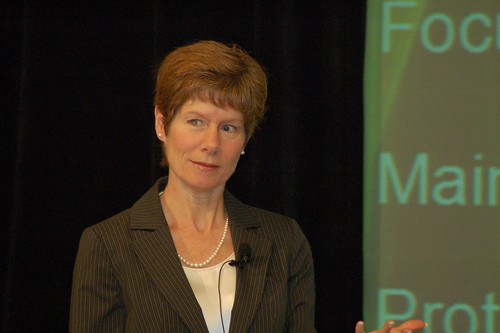 Janet Eden-Harris, CEO of Umbria opened up the discussion of Marketing 2.0 at the CMO Club "You're Not Alone Anymore" Summit in NYC.
Janet Eden-Harris, CEO of Umbria opened up the discussion of Marketing 2.0 at the CMO Club "You're Not Alone Anymore" Summit in NYC.As we're all aware, more and more decisions are being made through referrals. And if you're using classic marketing tactics you'd probably say to yourself, "I want to get the person who buys the most from me." But what we've learned in the hyperconnected world of social media, that person who buys the most from you may not necessarily be the most influential. Some influencers who don't buy much or at all could potentially be your greatest influencer.
Marketing 2.0 requires the following:
- Complex communications
- Blogs, message boards
- Focus on big influencers
- Social media
- Share the brand with your audience
- Engagement metrics (many different ways to measure)
- Crisis communication
- Blogger outreach
- Brand insight
- Industry analysis
- Customer insight
- Innovation ideas
Eden-Harris brought up three examples of companies that recognized an issue with their constituency and applied Marketing 2.0 tactics.
Dell
Notable blogger Jeff Jarvis spoke negatively about them and it opened the floodgates to endless criticism. The power of a single blogger beginning a chain reaction opened Dell's eyes to the need to speak in that community. Today Dell has two dozen people dedicated to monitoring boards online and they reach out and talk with people when they have a problem. Dell claims that its customer approval rating has soared as a result.
When I, David Spark, blog negatively about a company at my blog, The Spark Minute, I will get one of the three responses from the company in question:
- Nothing
- A request to please change my post yet they offer no explanation as to why I should. I respond asking them to explain what information was wrong and I'm kind of surprised that I never hear from them again.
- A message from someone in the company asking how they can help. We engage in dialogue and sometimes I find out that I made a mistake and they correct me, and as a result I fix the post.
The company was surprised to discover they weren't feeling the love from Gen-Y females. An in-house study revealed that Gen-Y females formed a negative sentiment about the company during Valentine's Day arguing that it was a manufactured holiday. Hallmark responded to this constituency by coming out with a sarcastic line of Valentine's Day cards.
Starbucks
The coffee house chain tracked anyone that talked about them online. One thing the company quickly realized is people who talk about coffee and Starbucks don't just talk about coffee and Starbucks and coffee. They talk about other things too. And it's there that Starbucks started to create and track indexes to learn more about their customers.







No comments:
Post a Comment